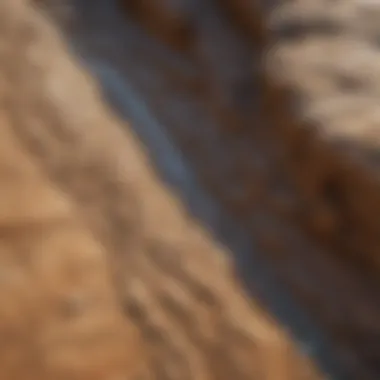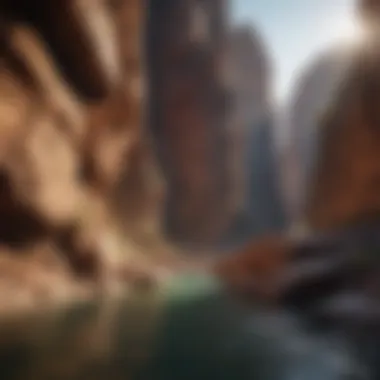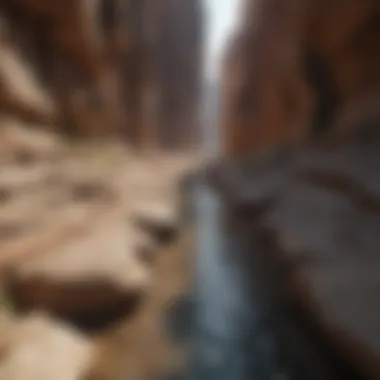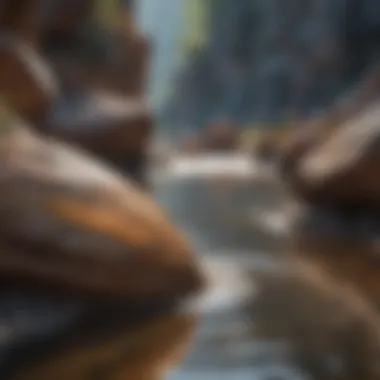The Enigmatic Phenomenon of Water Eroding Rock


Roc k and Fossil .Identification
In our exploration of the fascinating interplay between water and earth, it is imperative to recognize the key role of rock and fossil identification. Understanding the various types of rocks and fossils is essential to grasp the intricate processes involved in water erosion of geological formations. When embarking on this journey, it becomes crucial to discern the characteristics that distinguish one rock or fossil from another, providing insight into their origins and susceptibility to water erosion. Utilizing tools specifically designed for identification purposes further enhances our ability to delineate between different rock compositions and fossil structures, enriching our understanding of how water interacts with these geological elements over time.
Colecting Ti ps and Techniques
As we delve deeper into the realm of water cutting through rock formations, it is vital to consider the best practices for collecting specimens. Successful collection relies on a combination of meticulous techniques and astute observation. By understanding how to locate prime collecting sites, enthusiasts can maximize their chances of discovering well-preserved specimens that showcase the effects of water erosion on rocks and fossils. Moreover, learning how to safely extract these specimens ensures not only their integrity but also the safety of the collector during the process. By honing these collection skills, individuals can truly immerse themselves in the world of geological wonders shaped by the relentless force of water.
Preseravaton and Disply
Following the acquisition of rocks and fossils impacted by water erosion, the next crucial step lies in preservation and display. Employing effective techniques for preserving these geological finds is paramount to maintaining their integrity and revealing their inherent beauty. Proper storage methods play a pivotal role in safeguarding the specimens from environmental factors that could accelerate deterioration. Additionally, exploring creative display ideas allows enthusiasts to showcase their collections in visually engaging ways, offering a glimpse into the enduring impact of water on rock formations throughout history.
Geologacle Insights
Delving into the phenomenon of water cutting through rock opens up a realm of geological insights that shed light on the Earth's dynamic processes. Exploring different geological formations and the processes that shaped them unveils a tapestry of natural history rich with significance. By delving into the historical context of rocks and fossils impacted by water erosion, we gain a deeper appreciation for the enduring power of natural forces over time. Furthermore, studying notable discoveries in the field provides valuable insights into the scientific advancements and explorations that continue to reshape our understanding of the intricate relationship between water and rock.
Introduction
Water cutting through rock is indeed a remarkable process that showcases the sheer force and persistence of natural elements. In this article, we delve into this fascinating phenomenon, shedding light on the intricate interplay between water and rock formations over time. Understanding how water shapes the Earth's surface is crucial in appreciating the geological transformations that have taken place over millennia. We will explore the erosive power of water and its profound impact on landscapes, offering a comprehensive guide to the phenomenon of water cutting through rock formations.
Understanding Erosion
Erosion, the gradual wearing away of land surfaces by various agents like water, wind, and ice, plays a crucial role in shaping our natural environment. It is a process where rock or soil is disintegrated and transported from one place to another. Starting with the definition of erosion, we will delve into the different types of erosion and their significance in altering the Earth's topography. Additionally, we will examine the specific role that water plays in erosion processes, highlighting its efficiency as a geological sculptor.
Definition of Erosion
Erosion refers to the wearing away of rocks and soils by natural forces. This continuous process is essential for the reshaping of landscapes and the movement of sediment. The key characteristic of erosion lies in its ability to sculpt the Earth's surface gradually over time. Despite its slow pace, erosion is a powerful geological force that acts as a primary mechanism for change in landforms.
Different Types of Erosion
Various types of erosion exist, including wind erosion, glacier erosion, and fluvial erosion. Each type contributes uniquely to the geological evolution of landscapes. Water erosion, for instance, is particularly significant due to its effectiveness in reshaping terrains through processes like sediment transportation and deposition.
Role of Water in Erosion
Water, especially in the form of rivers and rainfall, is a vital catalyst for erosion. Its ability to carry and deposit sediments plays a key role in shaping valleys, canyons, and coasts. The relentless flow of water over time can carve deep gorges and intricate patterns on rocky surfaces, demonstrating the immense power it holds in sculpting the Earth's features.
Geological Significance
Beyond merely altering surfaces, erosion holds immense geological significance by contributing to the formation of landscapes. It influences the development of geological structures and plays a pivotal role in shaping the Earth's crust. Through examining the formation of landscapes and the impact on geological structures, we gain a deeper understanding of the intricate relationship between erosion processes and geological phenomena.


Formation of Landscapes
The formation of landscapes is a direct result of erosive processes acting over vast timescales. By studying how erosion sculpts terrains, we can uncover clues about the Earth's history and the forces that have shaped it. The gradual transformation of mountains, valleys, and plains showcases the ongoing geological processes driven by erosion.
Impact on Geological Structures
Erosion has a profound impact on geological structures, influencing the characteristics of rock formations and land masses. The constant wearing down of rocks by water and other erosive agents leads to the creation of unique landforms such as arches, canyons, and caves. This process not only alters the external appearance of landscapes but also reveals insights into the Earth's subsurface composition.
Water as a Powerful Force
Water, as a natural element, exerts immense power in shaping the Earth's surface through various mechanisms such as hydraulic action, abrasion processes, and chemical weathering. Understanding the role of water as a geological force is paramount in comprehending the complexities of erosion and landform development.
Hydraulic Action
Hydraulic action involves the mechanical force of water against rock surfaces, leading to their erosion. The sheer pressure exerted by moving water can dislodge particles and wear down solid structures over time. This process is particularly prominent in shaping riverbeds and coastlines, where water continuously interacts with rocky substrates.
mistype#### Abrasion Processes Abrasion processes, which involve the wearing away of rock surfaces by the friction of sediments carried by water, contribute significantly to erosion patterns. The continuous rubbing and grinding action of sediments against rocks result in their gradual erosion and smoothing. This abrasion process is vital in shaping valleys, canyons, and other erosional landforms.
Chemical Weathering
Chemical weathering refers to the dissolution of rocks through chemical reactions induced by water and other substances. This process alters the composition of rocks, leading to their breakdown and decomposition. Chemical weathering plays a crucial role in softening rocky surfaces, making them more susceptible to physical erosion by water and other agents.
Case Studies
Water's ability to shape and sculpt the landscape over time is a testament to nature's raw power. In the context of this article, case studies play a pivotal role in showcasing specific instances where water has cut through solid rock formations, leaving behind remarkable geological structures. By examining famous rock formations like the Grand Canyon and Victoria Falls, we gain valuable insights into the enduring impact of water erosion on Earth's surface.
Famous Rock Formations
Water, with its persistent force, has crafted some of the most breathtaking landscapes on our planet. Among these wonders, the Grand Canyon stands out as an iconic example of water's ability to carve through solid rock over millennia. The sheer magnitude of the Grand Canyon's size and depth showcases the relentless power of water erosion, exposing layers of geological history that tell a story of constant change and transformation.
Similarly, Victoria Falls presents a majestic display of water cutting through rock, creating a cascade of sheer beauty and natural artistry. The unique feature of Victoria Falls lies in its combination of height and width, making it one of the largest waterfalls globally and a remarkable testament to the erosive power of water over time. Its thunderous roar and misty spray remind us of the ceaseless force of nature at work.
Historical Perspectives
Understanding the historical context of how these rock formations came to be provides us with a deeper appreciation for the intricate processes at play. Canyon formation theories offer insights into the geological mechanisms that shaped these breathtaking landforms. By studying the various interpretations and scientific hypotheses surrounding canyon formation, we unravel the mysteries of the Earth's intricate past.
In addition to scientific theories, cultural interpretations of these geological marvels enrich our understanding of the relationship between humans and nature. Viewing these formations through cultural lenses allows us to appreciate how different societies have perceived and interacted with these natural wonders throughout history. Cultural interpretations add a layer of depth to our exploration of the phenomenon of water cutting through rock, underscoring the significance of these formations beyond their geological origins.
Scientific Explanations


Hydrological Processes
River Erosion
River Erosion stands as a fundamental facet of the broader discussion on the role of water in shaping our world. This process involves the gradual wearing away of soil, rocks, and sediment along riverbanks and beds, sculpting landscapes over millennia. The distinctive characteristic of River Erosion lies in its persistence and adaptability, constantly reshaping topographies through the relentless flow of water. By focusing on River Erosion, we uncover the critical link between river dynamics and landform evolution, shedding light on the underlying forces propelling this impactful geological process.
Waterfall Formation
Turning our attention to Waterfall Formation unveils a mesmerizing aspect of hydrological processes. The formation of waterfalls represents a captivating blend of erosive forces and differential rock resistance, culminating in stunning cascades etched into rocky terrains. The key allure of Waterfall Formation lies in its striking visual appeal and dynamic creation, encapsulating the dynamism of geological transformations. Exploring Waterfall Formation not only provides insights into landform development but also exemplifies the sheer power of water in sculpting breathtaking natural wonders.
Geological Time Scales
Rock Age Determination
Rock Age Determination plays a pivotal role in understanding the temporality of geological processes across eons. By employing various dating techniques and stratigraphic analyses, scientists unravel the ages of rocks and decipher the chronology of earth's geological history. The distinctive feature of Rock Age Determination lies in its ability to piece together the timelines of geological events, offering a glimpse into the vast timescales of our planet's formation and evolution. Delving into Rock Age Determination illuminates the intricate tapestry of rock formations and enriches our grasp of the deep-rooted history embedded in the Earth's crust.
Erosion Rates
Examining Erosion Rates provides critical insights into the pace and magnitude of landscape transformation over time. By quantifying the rates at which rocks weather and erode, geologists can gauge the dynamic nature of geological processes occurring on various scales. The significance of Erosion Rates stems from their role in assessing environmental changes, evaluating land vulnerability, and predicting future landscape evolution. Detailed analysis of Erosion Rates enhances our comprehension of the adaptive landscapes sculpted by continuous erosive forces, offering a nuanced perspective on the ever-changing face of our planet.
Environmental Implications
Water's erosion power extends beyond shaping landscapes; its impact on environmental systems is profound. Understanding the environmental implications of water cutting through rock goes beyond mere geological fascination. It involves the delicate balance of ecosystems and the cascading effects on habitat and biodiversity. Exploring this aspect sheds light on the interconnectedness of natural processes and the importance of preserving these delicate balances.
Ecosystem Impact
In examining the ecosystem impact of water cutting through rock, two crucial aspects come to the forefront: habitat changes and biodiversity.
Habitat Changes
The alteration of habitats due to water erosion is a critical environmental implication. It pertains to the modification of natural spaces where organisms reside, leading to significant ecological transformations. The key characteristic of habitat changes lies in their ability to reshape landscapes, influencing the distribution of flora and fauna. These changes can be both beneficial and detrimental, depending on the adaptability of species to the evolving environment. Understanding habitat changes is vital in gauging the resilience of ecosystems amidst continuous geological transformations.
Biodiversity
Biodiversity plays a fundamental role in the ecosystem impact of water carving through rock formations. It encompasses the variety of living organisms within a given habitat and reflects the health and stability of an ecosystem. The richness of biodiversity enhances ecosystem resilience, ensuring the survival of various species in the face of environmental changes. The unique feature of biodiversity lies in its capacity to adapt to diverse conditions, contributing to the sustainability of ecosystems. Examining biodiversity provides insights into the intricate web of life and the intricate balance necessary for ecological harmony. An in-depth exploration of biodiversity enriches our understanding of the significance of preserving natural diversity.
Climate Influence
Water's interaction with geological structures also influences climate patterns, further expanding its environmental implications.


Rainfall Patterns
The alteration of rainfall patterns due to water erosion impacts the distribution of water across landscapes, affecting vegetation and overall ecosystem health. Changes in rainfall patterns can lead to droughts or floods, disrupting the delicate balance of ecosystems. Understanding the key characteristic of rainfall patterns involves grasping the interconnectedness between water erosion, climate, and ecological stability. Investigating rainfall patterns provides crucial insights into water's role in shaping environmental conditions and the resulting impact on ecosystems.
Global Warming Effects
Water cutting through rock formations also influences global warming effects by releasing stored carbon dioxide and altering carbon cycles. The key characteristic of these effects lies in their contribution to climate change through the release of greenhouse gases. Understanding the unique feature of global warming effects sheds light on the intricate relationship between geological processes, climate, and environmental sustainability. Exploring these effects underscores the importance of considering water erosion's long-term impact on global climate patterns and the necessity of mitigating environmental degradation for future generations.
Preservation Efforts
Preservation Efforts play a pivotal role in safeguarding natural resources and maintaining ecological balance. In the context of rock formations and erosion, Preservation Efforts focus on implementing strategies to prevent degradation and loss of valuable geological heritage. These efforts are critical in ensuring the longevity and sustainability of landscapes for future generations. By curating Conservation Strategies such as Erosion Control Measures and Sustainable Practices, Preservation Efforts aim to mitigate the adverse effects of environmental factors on rock structures. The meticulous planning and execution of these strategies contribute significantly to preserving the intrinsic beauty and scientific value of geological formations. Recognizing the importance of conservation in maintaining ecological harmony, Preservation Efforts underscore the symbiotic relationship between human actions and the natural environment. It is imperative to raise awareness about the significance of preserving rock formations and to engage in proactive measures that uphold the integrity of these geological wonders.
Conservation Strategies
Erosion Control Measures
Erosion Control Measures encompass a range of techniques designed to mitigate the impact of erosive forces on rock formations. These measures include the implementation of physical barriers, vegetation cover enhancements, and sustainable land management practices. By strategically placing barriers and stabilizing slopes, Erosion Control Measures aim to reduce the velocity of water flow and minimize the risk of soil erosion. The key characteristic of Erosion Control Measures lies in their ability to maintain the structural integrity of rock formations while preserving the natural environment. Their effectiveness in preventing sediment runoff and maintaining landscape stability makes them a popular choice for rock conservation initiatives. Despite their effectiveness, Erosion Control Measures require periodic maintenance and monitoring to ensure sustained protection of geological sites. While the advantages of these measures include cost-effectiveness and minimal environmental disruption, the main disadvantage lies in their susceptibility to natural degradation over time.
Sustainable Practices
Sustainable Practices are essential components of Conservation Strategies aimed at promoting long-term environmental stewardship. These practices focus on adopting eco-friendly approaches to land use, promoting biodiversity conservation, and optimizing resource management. The key characteristic of Sustainable Practices is their emphasis on preserving the ecological balance while meeting the needs of present and future generations. By integrating renewable energy sources, promoting green infrastructure, and implementing waste reduction initiatives, Sustainable Practices strive to minimize the ecological footprint associated with human activities. Their significance in rock conservation lies in their ability to harmonize human development with environmental preservation, fostering a sustainable relationship with natural landscapes. While the advantages of Sustainable Practices include promoting environmental responsibility and enhancing ecosystem resilience, the main challenge lies in overcoming resistance to change and shifting towards more sustainable practices.
Educational Initiatives
Public Awareness Programs
Public Awareness Programs play a vital role in educating the public about the importance of conserving rock formations and promoting sustainable practices. These programs are designed to raise awareness about the adverse effects of environmental degradation on geological heritage and to inspire action towards conservation efforts. The key characteristic of Public Awareness Programs is their ability to engage diverse audiences in discussions about environmental conservation and stimulate behavior change. By leveraging various communication channels and organizing outreach events, Public Awareness Programs can effectively disseminate information on conservation practices and encourage community involvement. Their unique feature lies in their capacity to bridge the gap between scientific knowledge and public understanding, empowering individuals to become stewards of the environment. While the advantages of these programs include fostering a sense of environmental responsibility and mobilizing collective action, the main challenge lies in sustaining long-term engagement and commitment to conservation goals.
Geological Heritage Protection
Geological Heritage Protection initiatives are essential for safeguarding the scientific, educational, and aesthetic value of rock formations. These initiatives focus on preserving geological sites of significance through designation, monitoring, and management strategies. The key characteristic of Geological Heritage Protection is its emphasis on conserving unique geological features and promoting scientific research and education. By establishing protected areas, implementing buffer zones, and enforcing regulations, Geological Heritage Protection measures contribute to maintaining the integrity and authenticity of geological landscapes. Their unique feature lies in their role as custodians of geological diversity and geological heritage, ensuring that rock formations are preserved for future generations. While the advantages of these initiatives include promoting geological literacy and fostering appreciation for natural heritage, the main challenge lies in balancing conservation priorities with sustainable development goals.
Conclusion
In closing this comprehensive exploration of the phenomenon of water cutting through rock formations, it is crucial to reflect on the transformative power of nature. Through this article, we have delved into the intricate processes by which water shapes geological structures over time. By highlighting the erosion caused by water's powerful impact, we gain a deeper appreciation for the constant evolution of the Earth's surface. Understanding the role of water in carving through solid rock provides us with insights into the dynamic forces at play in shaping our environment. It emphasizes the importance of recognizing nature's ability to create and destroy, showcasing the delicate balance between permanence and impermanence in the natural world.
Reflection on Nature's Power
Beauty in Transformation
Exploring the theme of Beauty in Transformation within the context of water cutting rock allows us to observe the captivating changes that occur in landscapes over time. This specific aspect emphasizes the gradual but profound alterations that take place as water works its way through solid rock formations. The key characteristic of Beauty in Transformation lies in its ability to showcase the evolution of geological features with a unique aesthetic appeal. The gradual erosion and reshaping of rocks create a visually stunning array of forms, highlighting the dynamic nature of geological processes. While Beauty in Transformation offers a mesmerizing spectacle of natural artistry, it also serves to remind us of the impermanence of physical structures in the face of elemental forces.
Perpetual Evolution
In discussing Perpetual Evolution within the framework of water cutting rock, we underscore the continuous cycle of change that characterizes Earth's geological dynamics. Perpetual Evolution embodies the constant movement and transformation of landscapes under the influence of natural elements, particularly water. The key characteristic of this concept is its emphasis on the relentless adaptation and alteration of geological features over extended periods. Perpetual Evolution stands out as a vital aspect in understanding the long-term impact of erosion on rock formations, illustrating the ongoing process of shaping and reshaping the Earth's surface. While offering a deeper comprehension of the geological timescales involved, Perpetual Evolution also serves as a reminder of the Earth's ever-changing nature, urging us to appreciate the dynamic interplay between land and water in a state of perpetual flux.







